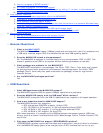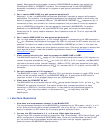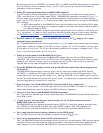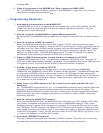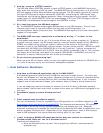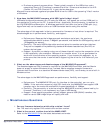
speed). Most applications that seem to require ISOCHRONOUS bandwidth can actually be
handled with BULK or INTERRUPT transfers. This is because most of the ISOCHRONOUS
bandwidth available to a USB device in a system is also typically available for BULK/INT
transfers.
5. Can I use the MAX3420E in a self-powered peripheral?
Absolutely. In fact, the MAX3420E has features specifically intended to support self-powered
applications. For example, in a self-powered application the peripheral needs to know when the
device is plugged into a powered USB port. The MAX3420E's VBCOMP (V
BUS
comparator) pin is
connected to V
BUS
, and routed to an internal comparator that provides an interrupt request at
plug-in (VBUSIRQ) and another interrupt request at disconnect (NOVBUSIRQ). As another
example for the MAX3420E, a bit called VBGATE (V
BUS
gate) can be set to automatically
disconnect the D+ pullup resistor whenever V
BUS
is detected to be off. This is a required USB
specification.
6. Can I use the MAX3420E in a bus-powered peripheral?
Yes. In a bus-powered application, a 3.3V voltage regulator is connected to the USB connector's
V
BUS
pin. Whenever the peripheral is plugged into USB, the chip and the SPI master driving it are
powered. So there is no need to connect the MAX3420's VBCOMP pin to V
BUS
. In this case, the
VBCOMP input can be used as an extra general-purpose input. Care must be taken to ensure that
input signals to this pin meet the threshold requirements noted in the
MAX3420 Electrical
Characteristics table.
7. What external circuitry do I need to connect the MAX3420E to USB?
The MAX3420E requires a V
CC
supply of 3.3V. Bus-powered peripherals need a 3.3V regulator to
convert the power available on the V
BUS
pin (4.4V to 5.25V) to 3.3V. In addition, the MAX3420E
requires an external crystal (parallel resonant, 12MHz ±0.25%) with load capacitors from each
pin to ground, and two series resistors (33
, 1%) between the D+/D- outputs, and the USB "B"
connector.
8. Can you recommend a 3.3V regulator?
The MAX6349TL is ideal. It supplies 150mA at 3.3V, and contains a power-on-reset (POR) circuit
which can be connected directly to the MAX3420E RES# pin. A good external POR circuit is
important to have in a hot-plugged design such as a USB peripheral.
9. What does the CONNECT bit do?
The MAX3420E has a switchable internal 1500 pullup resistor between its D+ pin and V
CC
. The
CONNECT bit operates this switch. This switch allows a bus- powered peripheral to delay
connection to USB until it finishes initialization. It also allows a self-powered peripheral to
remove V
CC
from the pullup resistor in the absence of V
BUS
, as required by the USB
Specification.
3.
Interface Questions
1. How does a microprocessor connect to the MAX3420E?
The microprocessor connects to the MAX3420E by implementing an SPI master, using 3, 4, or 5
wires. Some microcontrollers include hardware SPI, but many do not. In this latter case, it is
easy to implement an SPI master by bit-banging general-purpose IO pins.
2. You say the SPI interface is 3, 4, or 5 wires. What does this mean?
The minimum SPI interface consists of three wires: SS# (Slave Select), SCLK (Serial Clock), and
MISO (configured for bidirectional MISO/MOSI data). Since this interface does not use the INT
pin, the controlling microprocessor would need to poll two interrupt-request registers to
determine when the MAX3420E requires service.




